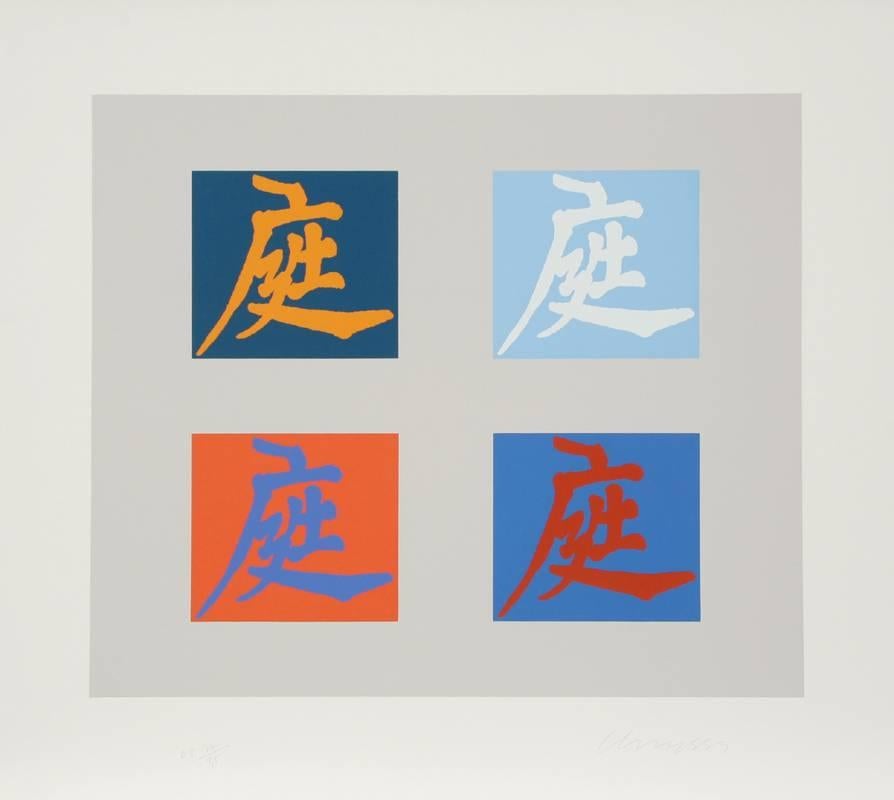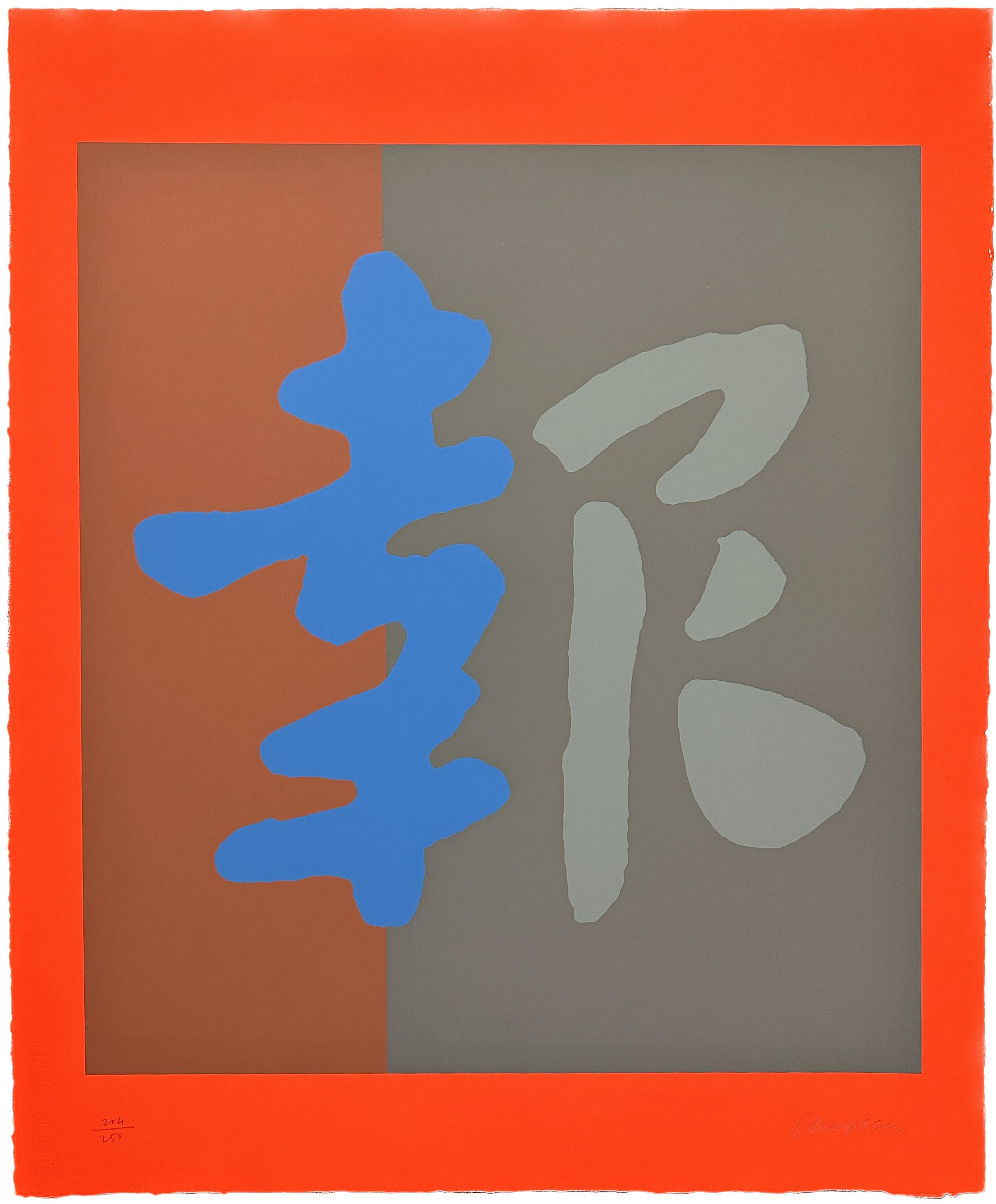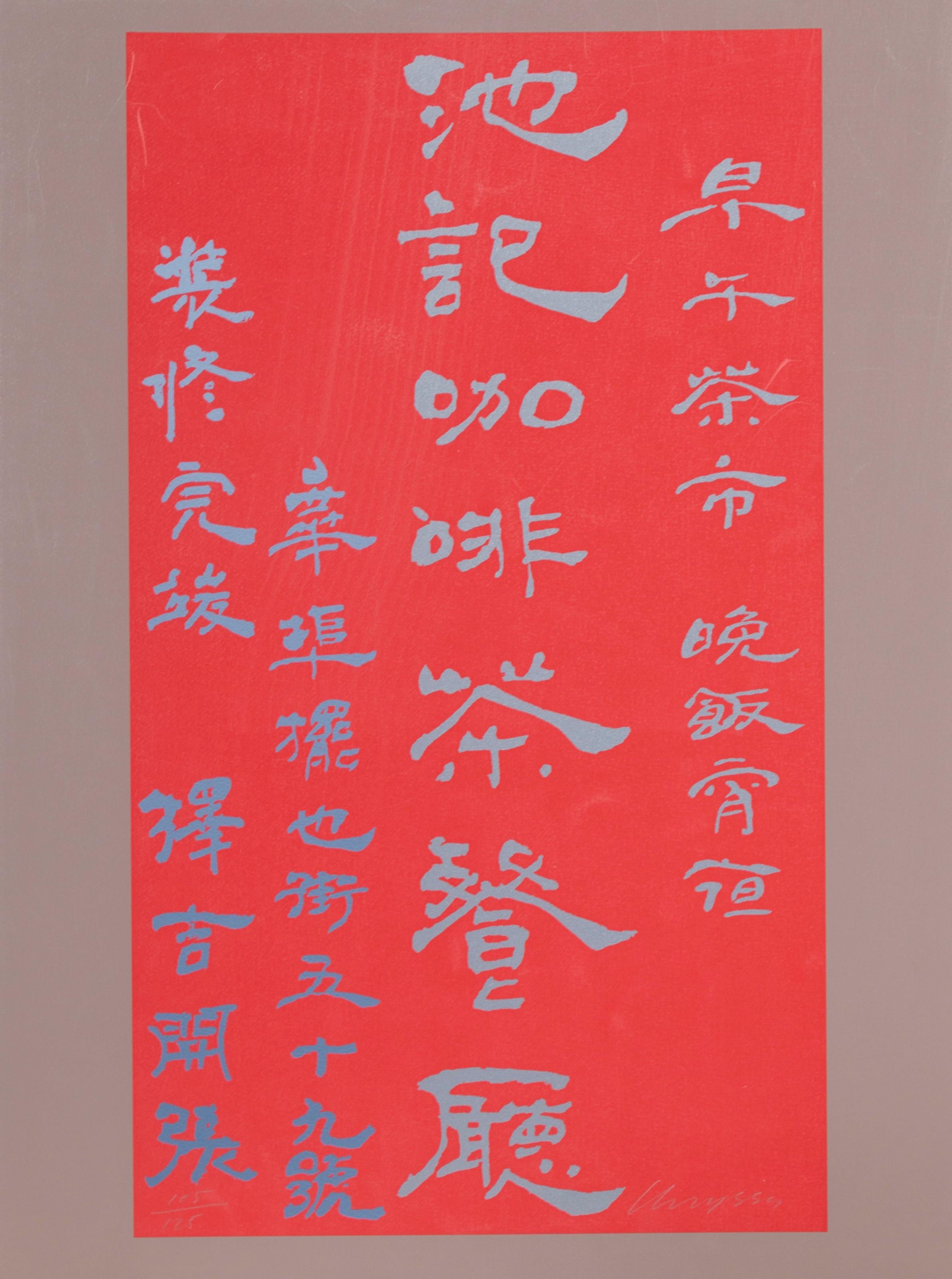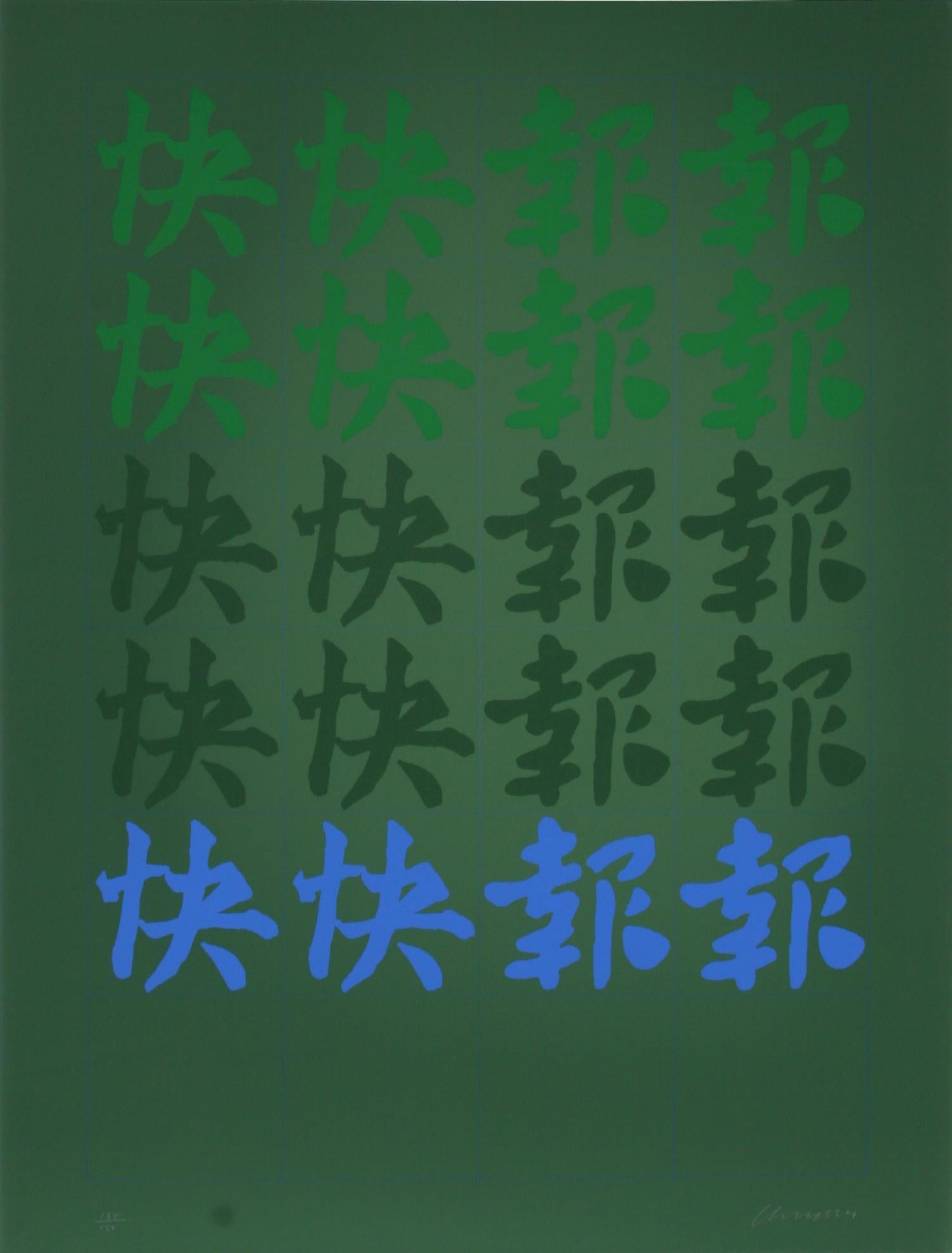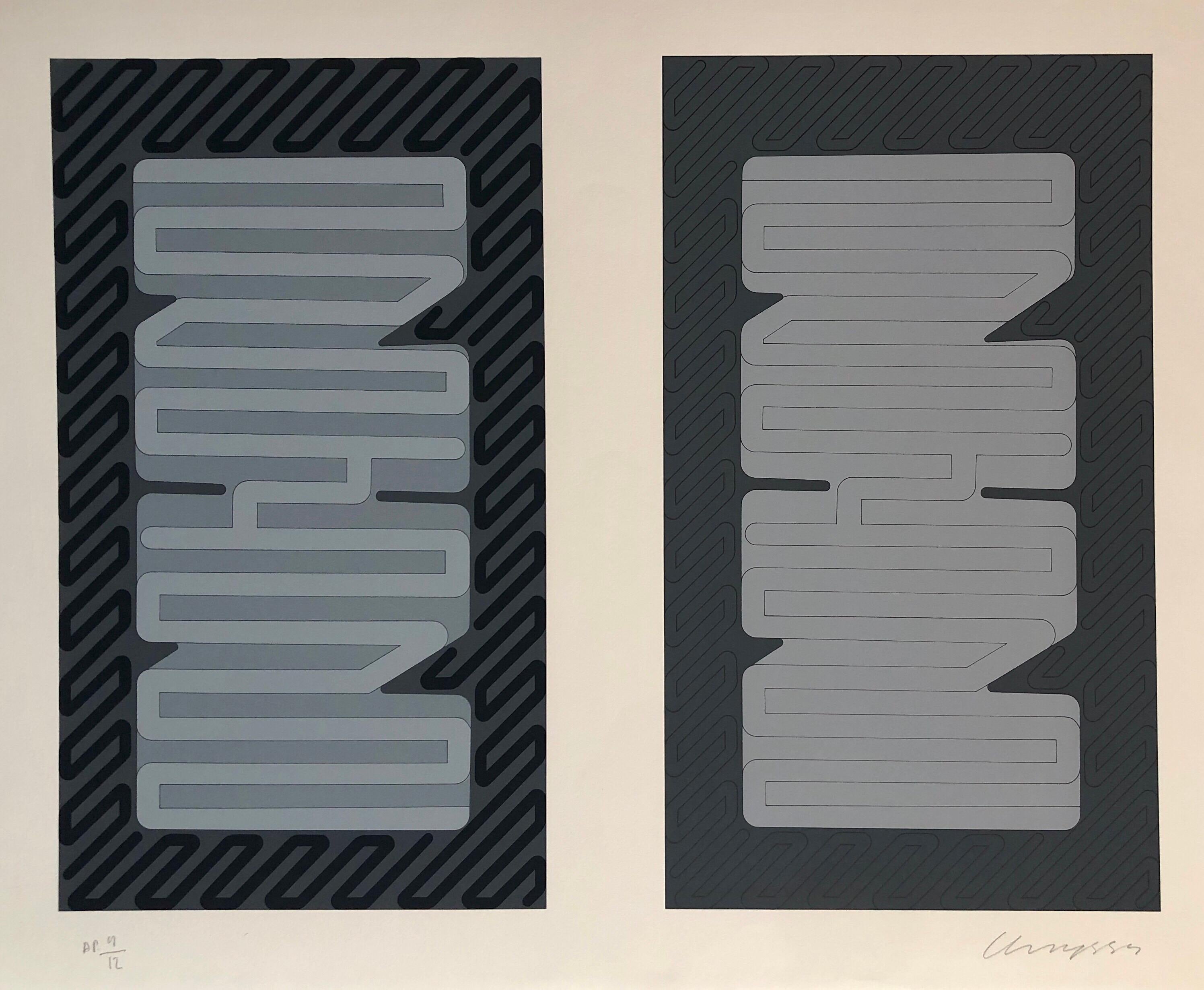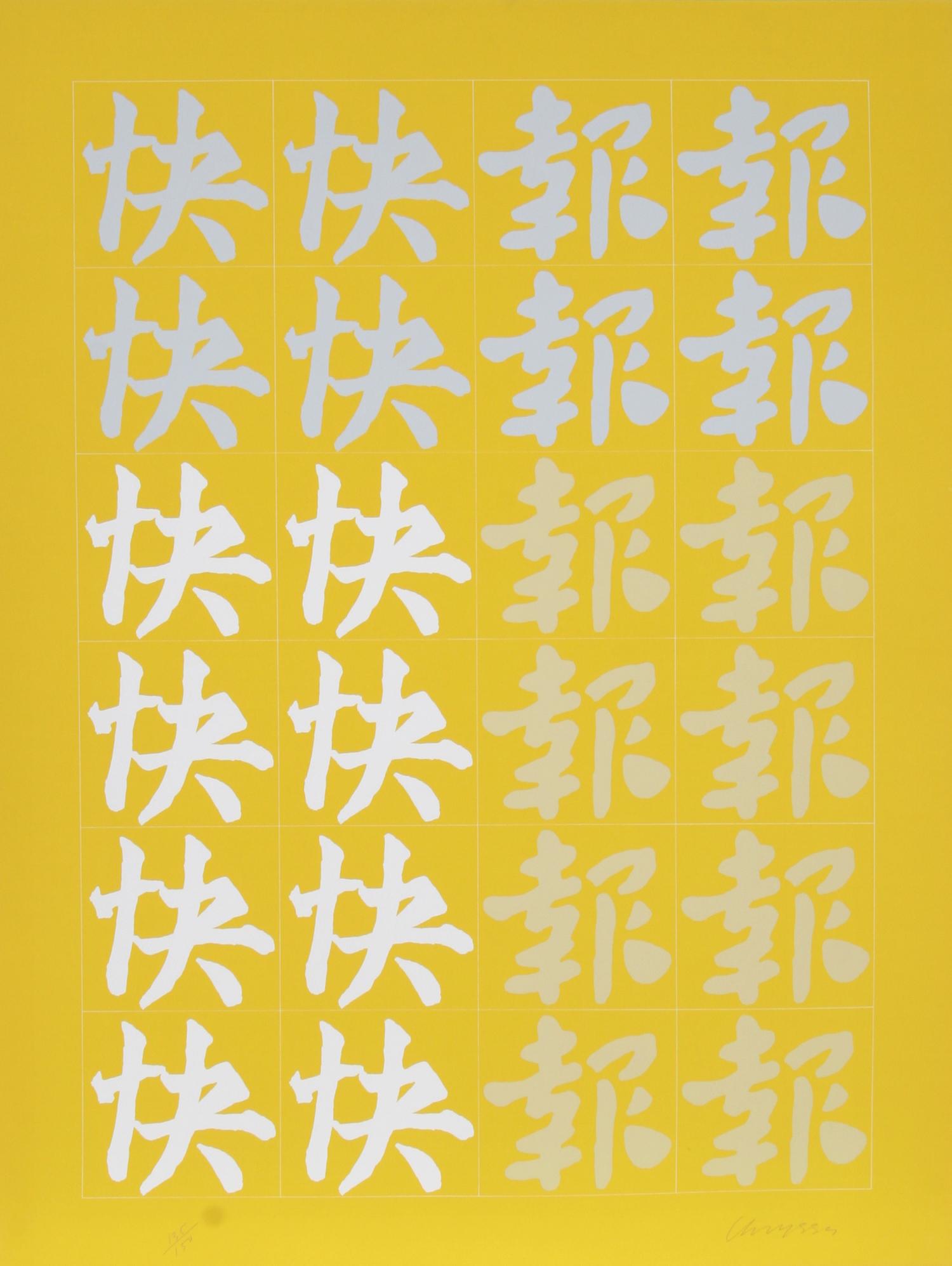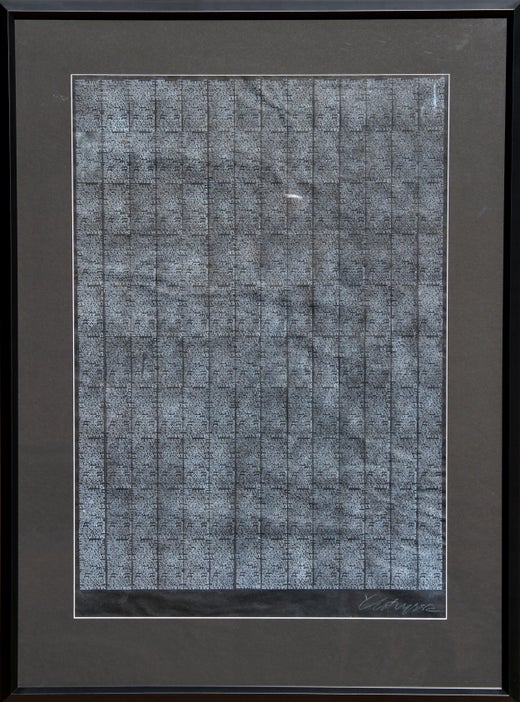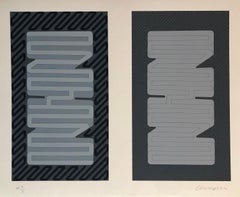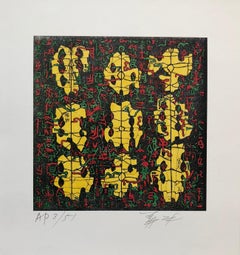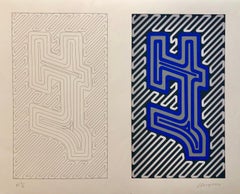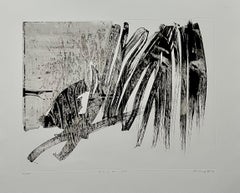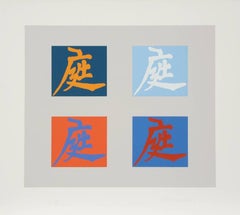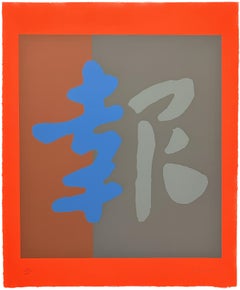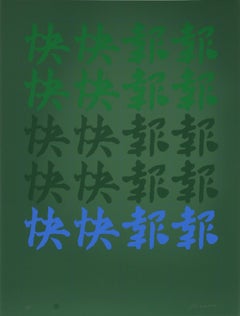Items Similar to 1980's Large Silkscreen Chinese Characters Serigraph Pop Art Print China
Want more images or videos?
Request additional images or videos from the seller
1 of 8
Chryssa Vardea-Mavromichali1980's Large Silkscreen Chinese Characters Serigraph Pop Art Print China1980
1980
$850
£642.32
€741.72
CA$1,187.75
A$1,317.91
CHF 690.35
MX$16,161.05
NOK 8,780.98
SEK 8,288.87
DKK 5,531.46
Shipping
Retrieving quote...The 1stDibs Promise:
Authenticity Guarantee,
Money-Back Guarantee,
24-Hour Cancellation
About the Item
Chryssa Vardea-Mavromichali (Greek: Χρύσα Βαρδέα-Μαυρομιχάλη; December 31, 1933 – December 23, 2013) was a Greek American artist who worked in a wide variety of media. An American art pioneer in light art and luminist sculpture widely known for her neon, steel, aluminum and acrylic glass installations, she has always used the mononym Chryssa professionally. She worked from the mid-1950s in New York City studios and worked since 1992 in the studio she established in Neos Kosmos, Athens, Greece.
Chryssa was born in Athens into the famous Mavromichalis family from the Mani Peninsula. one of her sisters, who studied medicine, was a friend of the poet and novelist Nikos Kazantzakis.
Chryssa began painting during her teenage years and also studied to be a social worker.In 1953, on the advice of a Greek art critic, her family sent her to Paris to study at the Académie de la Grande Chaumiere where Andre Breton, Edgard Varese, and Max Ernst were among her associates and Alberto Giacometti was a visiting professor.
In 1954, at age twenty-one, Chryssa sailed for the United States, arrived in New York and went to San Francisco, California to study at the California School of Fine Arts. Returning to New York in 1955, she became a United States citizen and established a studio in the city.
Chryssa's first major work was The Cycladic Books preceded American minimalism by seventeen years.
1961, Chryssa's first solo exhibition was mounted at The Guggenheim.
1963, Chryssa's work was shown at the Museum of Modern Art in curator Dorothy Canning Miller's Americans 1963 exhibition. The artists represented in the show also included Richard Anuszkiewicz, Lee Bontecou, Robert Indiana, Richard Lindner, Marisol, Claes Oldenburg, Ad Reinhardt, James Rosenquist and others.
1966, The Gates to Times Square, regarded as "one of the most important American sculptures of all time" and "a thrilling homage to the living American culture of advertising and mass communications." The work is a 10 ft cube installation of two huge letter 'A's through which visitors may walk into "a gleaming block of stainless steel and Plexiglas that seems to quiver in the play of pale blue neon light" which is controlled by programmed timers. First shown in Manhattan's Pace Gallery, it was given to the Albright-Knox Art Gallery in Buffalo, New York in 1972.
1972, The Whitney Museum of American Art mounted a solo exhibition of works by Chryssa.
That's All (early 1970s), the central panel of a triptych related to The Gates of Times Square, was acquired by the Museum of Modern Art between 1975 and 1979.
1973, Chryssa's solo exhibition at the Gallerie Denise René was reviewed for TIME magazine by art critic Robert Hughes before it went on to the Galleries Denise René in Düsseldorf and Paris.
Other works by Chryssa in composite honeycomb aluminum and neon in the 1980s and 1990s include Chinatown, Siren, Urban Traffic, and Flapping Birds.
Chryssa 60/90 retrospective exhibition in Athens in the Mihalarias Art Center. After her long absence from Greece, a major exhibition including large aluminum sculptures - cityscapes, "neon boxes" from the Gates to the Times Square, paintings, drawings etc. was held in Athens.
In 1992, after closing her SoHo studio, which art dealer Leo Castelli had described as "one of the loveliest in the world," Chryssa returned to Greece. She found a derelict cinema which had become a storeroom stacked with abandoned school desks and chairs, behind the old Fix Brewery near the city center in Neos Kosmos, Athens. Using the desks to construct enormous benches, she converted the space into a studio for working on designs and aluminum composite honeycomb sculptures. The Athens National Museum of Contemporary Art, which was founded in 2000 and owns Chryssa's Cycladic Books, is in the process of converting the Fix Brewery into its permanent premises.
Greek Exhibits, European Cultural Center of Delphi (Council of Europe). "Apollo's Heritage"(July 4, 2003 – July 30, 2003). Works by sixteen artists: Giorgio de Chirico, Salvador Dalí, Nikos Hadjikyriakos-Ghikas, Nikos Engonopoulos, Yannis Tsarouchis, Giorgos Sikeliotis, Takis, Arman, Fernando Botero, Chryssa, Dimitris Mytaras, Alekos Fassianos, Sarantis Karavouzis, Yiannis Psychopedis, Dimitris Sakellion, Georgios Xenos.
European Cultural Center of Delphi (Council of Europe). "Columns and Pillars" (July 1, 2005 – July 23, 2005). Works by Yannis Moralis, Costas Tsoclis, Alekos Fassianos, Sotiris Sorogas, Pavlos, Yiannis Psychopedis, Dimitris Mytaras, Opy Zouni, Novello Finotti, Stephan Antonakos, Chryssa, Günther Uecker, and others.
Solo exhibitions
1961: Solomon R. Guggenheim Museum
1965: Institute of Contemporary Art, Philadelphia
1968: Harvard University
1972: Whitney Museum of American Art
1979: Musée d'Art Moderne de la Ville de Paris
Group exhibitions
1961: Le Nouveau Réalisme à Paris et à New York, Galerie Rive Droite, Paris, June 1961
1963: Museum of Modern Art
1977: Documenta '77 in Kassel
1991: Princeton University Art Museum
1997: Leo Castelli Gallery
2000, 2003 & 2005: European Cultural Center of Delphi
2007: Hirshhorn Museum and Sculpture Garden
Collections
Albright-Knox Art Gallery
Boca Raton Museum of Art
Corcoran Gallery of Art
Empire State Plaza
Hirshhorn Museum and Sculpture Garden
Macedonian Museum of Contemporary Art in Thessaloniki
Museum of Modern Art
National Museum of Contemporary Art in Athens
Walker Art Center
Whitney Museum of American Art
- Creator:Chryssa Vardea-Mavromichali (1933 - 2013, Greek)
- Creation Year:1980
- Dimensions:Height: 25 in (63.5 cm)Width: 34 in (86.36 cm)
- Medium:
- Movement & Style:
- Period:
- Condition:minor wear.
- Gallery Location:Surfside, FL
- Reference Number:1stDibs: LU38213537702
Chryssa Vardea-Mavromichali
Chryssa, (born Chryssa Vardea Mavomichali) is best known for her "Luminist" sculpture in brilliantly colored neon tubing, was born in Greece and now ranks as one of the outstanding and innovative artists in America today. Chryssa has had individual and collective exhibition shows at the Museum of Modern Art, The Guggenheim, The Whitney -New York. Harvard University; Institute of Contemporary Art at the University of Pennsylvania; Carnegie Institute among many others.
About the Seller
4.9
Platinum Seller
Premium sellers with a 4.7+ rating and 24-hour response times
Established in 1995
1stDibs seller since 2014
1,780 sales on 1stDibs
Typical response time: <1 hour
- ShippingRetrieving quote...Shipping from: Surfside, FL
- Return Policy
Authenticity Guarantee
In the unlikely event there’s an issue with an item’s authenticity, contact us within 1 year for a full refund. DetailsMoney-Back Guarantee
If your item is not as described, is damaged in transit, or does not arrive, contact us within 7 days for a full refund. Details24-Hour Cancellation
You have a 24-hour grace period in which to reconsider your purchase, with no questions asked.Vetted Professional Sellers
Our world-class sellers must adhere to strict standards for service and quality, maintaining the integrity of our listings.Price-Match Guarantee
If you find that a seller listed the same item for a lower price elsewhere, we’ll match it.Trusted Global Delivery
Our best-in-class carrier network provides specialized shipping options worldwide, including custom delivery.More From This Seller
View All1970's Large Silkscreen Abstract Geometric Day Glo Serigraph Pop Art Print Neon
By Chryssa Vardea-Mavromichali
Located in Surfside, FL
Silkscreen on Arches paper, Hand signed and Numbered in Pencil. Serigraph in black, gray (silver).
Chryssa Vardea-Mavromichali (Greek: Χρύσα Βαρδέα-Μαυρομιχάλη; December 31, 1933 – December 23, 2013) was a Greek American artist who worked in a wide variety of media. An American art pioneer in light art and luminist sculpture widely known for her neon, steel, aluminum and acrylic glass installations, she has always used the mononym Chryssa professionally. She worked from the mid-1950s in New York City studios and worked since 1992 in the studio she established in Neos Kosmos, Athens, Greece.
Chryssa was born in Athens into the famous Mavromichalis family from the Mani Peninsula. one of her sisters, who studied medicine, was a friend of the poet and novelist Nikos Kazantzakis.
Chryssa began painting during her teenage years and also studied to be a social worker.In 1953, on the advice of a Greek art critic, her family sent her to Paris to study at the Académie de la Grande Chaumiere where Andre Breton, Edgard Varese, and Max Ernst were among her associates and Alberto Giacometti was a visiting professor.
In 1954, at age twenty-one, Chryssa sailed for the United States, arrived in New York and went to San Francisco, California to study at the California School of Fine Arts. Returning to New York in 1955, she became a United States citizen and established a studio in the city.
Chryssa's first major work was The Cycladic Books preceded American minimalism by seventeen years.
1961, Chryssa's first solo exhibition was mounted at The Guggenheim.
1963, Chryssa's work was shown at the Museum of Modern Art in curator Dorothy Canning Miller's Americans 1963 exhibition. The artists represented in the show also included Richard Anuszkiewicz, Lee Bontecou, Robert Indiana, Richard Lindner, Marisol, Claes Oldenburg, Ad Reinhardt, James Rosenquist and others.
1966, The Gates to Times Square, regarded as "one of the most important American sculptures of all time" and "a thrilling homage to the living American culture of advertising and mass communications." The work is a 10 ft cube installation of two huge letter 'A's through which visitors may walk into "a gleaming block of stainless steel and Plexiglas that seems to quiver in the play of pale blue neon light" which is controlled by programmed timers. First shown in Manhattan's Pace Gallery, it was given to the Albright-Knox Art Gallery in Buffalo, New York in 1972.
1972, The Whitney Museum of American Art mounted a solo exhibition of works by Chryssa.
That's All (early 1970s), the central panel of a triptych related to The Gates of Times Square, was acquired by the Museum of Modern Art between 1975 and 1979.
1973, Chryssa's solo exhibition at the Gallerie Denise René was reviewed for TIME magazine by art critic Robert Hughes before it went on to the Galleries Denise René in Düsseldorf and Paris.
Other works by Chryssa in composite honeycomb aluminum and neon in the 1980s and 1990s include Chinatown, Siren, Urban Traffic, and Flapping Birds.
Chryssa 60/90 retrospective exhibition in Athens in the Mihalarias Art Center. After her long absence from Greece, a major exhibition including large aluminum sculptures - cityscapes, "neon boxes" from the Gates to the Times Square, paintings, drawings etc. was held in Athens.
In 1992, after closing her SoHo studio, which art dealer Leo Castelli had described as "one of the loveliest in the world," Chryssa returned to Greece. She found a derelict cinema which had become a storeroom stacked with abandoned school desks and chairs, behind the old Fix Brewery near the city center in Neos Kosmos, Athens. Using the desks to construct enormous benches, she converted the space into a studio for working on designs and aluminum composite honeycomb sculptures...
Category
1980s Pop Art Abstract Prints
Materials
Screen
Chinese Abstract Modernist Signed Lithograph Hong Kong Modern Art
By Cheung Yee (Zhang Yi)
Located in Surfside, FL
Cheung Yee 張義 (b. 1936)
Born in Guangzhou, China, Cheung Yee graduated from the Fine Art Department of Taiwan Normal University in 1958, and five years later he formed the Circle Gr...
Category
20th Century Modern Abstract Prints
Materials
Lithograph
1970's Large Silkscreen Abstract Geometric Day Glo Serigraph Pop Art Print Neon
By Chryssa Vardea-Mavromichali
Located in Surfside, FL
Silkscreen on Arches paper, Hand signed and Numbered in Pencil. Serigraph in white, back, blue gray (silver).
Chryssa Vardea-Mavromichali (Greek: Χρύσα Βαρδέα-Μαυρομιχάλη; December 31, 1933 – December 23, 2013) was a Greek American artist who worked in a wide variety of media. An American art pioneer in light art and luminist sculpture widely known for her neon, steel, aluminum and acrylic glass installations, she has always used the mononym Chryssa professionally. She worked from the mid-1950s in New York City studios and worked since 1992 in the studio she established in Neos Kosmos, Athens, Greece.
Chryssa was born in Athens into the famous Mavromichalis family from the Mani Peninsula. one of her sisters, who studied medicine, was a friend of the poet and novelist Nikos Kazantzakis.
Chryssa began painting during her teenage years and also studied to be a social worker.In 1953, on the advice of a Greek art critic, her family sent her to Paris to study at the Académie de la Grande Chaumiere where Andre Breton, Edgard Varese, and Max Ernst were among her associates and Alberto Giacometti was a visiting professor.
In 1954, at age twenty-one, Chryssa sailed for the United States, arrived in New York and went to San Francisco, California to study at the California School of Fine Arts. Returning to New York in 1955, she became a United States citizen and established a studio in the city.
Chryssa's first major work was The Cycladic Books preceded American minimalism by seventeen years.
1961, Chryssa's first solo exhibition was mounted at The Guggenheim.
1963, Chryssa's work was shown at the Museum of Modern Art in curator Dorothy Canning Miller's Americans 1963 exhibition. The artists represented in the show also included Richard Anuszkiewicz, Lee Bontecou, Robert Indiana, Richard Lindner, Marisol, Claes Oldenburg, Ad Reinhardt, James Rosenquist and others.
1966, The Gates to Times Square, regarded as "one of the most important American sculptures of all time" and "a thrilling homage to the living American culture of advertising and mass communications." The work is a 10 ft cube installation of two huge letter 'A's through which visitors may walk into "a gleaming block of stainless steel and Plexiglas that seems to quiver in the play of pale blue neon light" which is controlled by programmed timers. First shown in Manhattan's Pace Gallery, it was given to the Albright-Knox Art Gallery in Buffalo, New York in 1972.
1972, The Whitney Museum of American Art mounted a solo exhibition of works by Chryssa.
That's All (early 1970s), the central panel of a triptych related to The Gates of Times Square, was acquired by the Museum of Modern Art between 1975 and 1979.
1973, Chryssa's solo exhibition at the Gallerie Denise René was reviewed for TIME magazine by art critic Robert Hughes before it went on to the Galleries Denise René in Düsseldorf and Paris.
Other works by Chryssa in composite honeycomb aluminum and neon in the 1980s and 1990s include Chinatown, Siren, Urban Traffic, and Flapping Birds.
Chryssa 60/90 retrospective exhibition in Athens in the Mihalarias Art Center. After her long absence from Greece, a major exhibition including large aluminum sculptures - cityscapes, "neon boxes" from the Gates to the Times Square, paintings, drawings etc. was held in Athens.
In 1992, after closing her SoHo studio, which art dealer Leo Castelli had described as "one of the loveliest in the world," Chryssa returned to Greece. She found a derelict cinema which had become a storeroom stacked with abandoned school desks and chairs, behind the old Fix Brewery near the city center in Neos Kosmos, Athens. Using the desks to construct enormous benches, she converted the space into a studio for working on designs and aluminum composite honeycomb sculptures...
Category
1980s Pop Art Abstract Prints
Materials
Screen
Abstract Expressionist Taiwanese Etching Chihung Yang Chinese Calligraphy Art
Located in Surfside, FL
S.O.C. #2
2014
Etching
76.5 x 91cm
Yang Chihung (Chinese: 楊識宏; pinyin: Yang Chihung; born 1947) Taiwanese-American artist.
Yang Chi-hung was born on 25 October 1947, in Chungli, Taiwan. He developed an interest in art in early childhood, and found inspirations to pursue an artist career after reading Lust for Life – The Life of Vincent van Gogh, translated by poet Yu Kuang-chung, in junior high school. Between 1965 and 1968, he attended the National Taiwan College of Art, developing a sound foundation in oil painting under the tutelage of famous Taiwanese artists of the Japanese Colonial period, such as Liao Chi-chun, Li Mei-shu and Yang San-lang. Meanwhile, he actively attended events organized by the modern art groups of Taiwan, namely the Fifth Moon Group and Ton Fan Group, only to find himself both intimidated and dissatisfied with the then relatively conservative art environment in Taiwan. In 1979, he emigrated to the United States of America with his wife, Jane, and their son, Daniel. His pioneering works soon landed him the “Outstanding Asian-American Artist” award. The concept and style of abstract expressionism as represented by the works of Jackson Pollock in the 1950s had great impact on Yang’s work. With the sense of nihilism that gave rise to abstract expressionism in the post-war period, artists no longer clamored to depict the external environment, but rather chose to focus on their own inner experience. Yang Chihung embraced this spirit about the early 1990s when his style turned abstract. In 1984–85 and again in 1985–86, he was twice awarded a year's residency at The Clocktower Studio in New York City by MoMA P.S.1.
In 2013, Yang, along with Xu Bing, Zhang Huan, and Li Chen, were the four artists featured in the Discovery Channel Asia documentary series, Chineseness, a multi-series production that focused on postwar Chinese contemporary artists.
He is of the generation of artists such as Chen Tingshi, Liang Yifeng, Yang Yuyu, Pang Jiun, Yinhui Chen, Jui-Ling Hung, De-Jinn Shiy, Yong-ik Cho, Wan Chuan Chang, Kuosung Liu, Sanlang Yang, Chetsai Shen, Fu-sheng Ku, Chunxiang Zhao, Ming Ju, Ming-Che Huang, Jiutong Liu, In-Ting Ran, George Chann, Yi Hong, Tzu-Chi Yeh, Max Liu, Yi-Hsiung Chang, Che Chuang
Awards and recognition
1989, Outstanding Asian American Artist Award, by Governor of New York
1984–1986, MoMA P.S.1 National Studio Program, Residency at Clocktower Studio, New York
SELECTED GROUP EXHIBITIONS
1969 Contemporary Young Artists Exhibition, U. S. I. S. Lincoln Center, Taipei, Taiwan
1974 Asian Contemporary Art Exhibition, Ueno Museum of Art, Tokyo, Japan
1977 10 Chinese Leading Artists, Metropolitan Museum of Art, Tokyo, Japan
1978 Contemporary Chinese Art from Taiwan, Hong Kong Arts Centre, Hong Kong
1978 International Exhibition of Prints, National Museum of Modern Art, Seoul, South Korea
1979 6th British International Print Biennial, Bradford Art Galleries and Museum, England
1980 4th Miami International Print Biennial, Metropolitan Museum Coral Gables, Florida
1982 Summer Invitational, Susan Caldwell Inc, New York City
1982 Four Artists, SoHo Center for Visual Artists, New York City
1983 New Acquisitions and Trustee's Choice, The Aldrich Museum of Contemporary Art,
1983 Cleveland (UK) 6th International Drawing Biennale, Middlesbrough Art Gallery, England
1983 Dreams Demons Madness, Alternative Museum, New York City
1984 Rambunctious, Siegel Contemporary Art, New York City
1984 Invitational Painting Exhibition, Part II: Eight Imagist Painters, Siegel Contemporary Art, NYC
1984 Salvo, Ruth Siegel Ltd, New York
1984 Modern Art, Ted Greenwald Gallery, New York City
1985 Exotica, Paintings and Works on Paper, Stephen Rosenberg Gallery, New York City
1985 The Art of the 1970s and 1980s, Aldrich Museum of Contemporary Art, Ridgefield, CT
1985 Large Figurative Drawings, Virginia Museum of Fine Arts, Richmond, Virginia
1985 Studio Programs, 1984 -1985, The Institute for Art and Urban Resources, Inc,
The Clocktower, New York City
1985 Surplus, Exit Art, New York City
1985 Four Painters From New York, Janet Steinberg Gallery, San Francisco, California
1985 Harvest, Ruth Siegel Ltd, New York City
1986 The Object Revitalized, The Paine Art Center and Arboretum, Oshkosh, Wisconsin
1986 Annual Juried Exhibition '86, The Queens Museum, New York City
1986 Summer Group Show, Galleri Mustad, Sweden
1987 New Work - New York, Helander Gallery, Palm Beach, Florida
1988 The Shell: Design Spirit, Bergen Museum of Art and Science, Paramus, New Jersey
1988 Works on Paper, Nina Freudenheim Gallery, Buffalo, New York
1988 The Flower Show, Betsy Rosenfield Gallery, Chicago, Illinois
1988 Classical Myth and Imagery in Contemporary Art, The Queens Museum, Flushing, NY
1988 Continuity and Change; Five Contemporary Chinese Artists, Yale University Art Gallery
1988 First Anniversary Exhibition, Michael Walls Gallery, New York City
1989 Second Anniversary Exhibition, Michael Walls Gallery, New York City
1990 The Matter At Hand; Contemporary Drawings, UWM Art Museum, University of Wisconsin,
1991 Entr'acte, Michael Walls Gallery, New York City
1991 Taipei - New York: Confrontation of Modernism, The Taipei Fine Arts Museum. Taiwan
1991 Past Becoming Future, The Contemporary Art Gallery, Seibu, Tokyo, Japan
1992 Intimate Universe; Small-Scale Paintings By Twenty-five American Artists, Michael Walls
1993 Paper Trails; The Eidetic Image, Krannert Art Museum, University of Illinois, Champaign,
1993 Intimate Universe, Nina Freudenheim Gallery, Buffalo, New York
1994 Isn't It Romantic? On Crosby Street, New York City
1994 To enchant (blue), Cynthia McCallister Gallery/Bixler Gallery, New York City
1994 Singapore International Art Fair, Sarina Tang Fine Art, Singapore
1994 Taipei Modem Art Exhibition, The National Gallery, Bangkok, Thailand
1995 A Romantic Impulse: Seventeen American Artists, O'Hara Gallery, New York City
1995 Chinese Artists in the United States, Hong Kong Land Limited, The Rotunda, Hong Kong
1996 Taipei Modern Art Exhibition, Shanghai Museum, Shanghai, China
1996 In Full Bloom: Flower and Garden Paintings, Lizan-Tops Gallery, East Hampton, New York
1997 Intimate Universe [Revisited], Robert Steele Gallery, New York City
1997 A Thought Intercepted, California Museum of Art, Santa Rosa, California
1997 Forces of Nature, Taipei Gallery, New York City,
1997 Lizan-Tops Gallery, East Hampton, New York
1998 Asian Aesthetic, Takara/Yukiko Lunday Gallery, Houston, Texas
1998 Contemporary Art from the Overseas Chinese, Galerie Pierre, Taichung, Taiwan
1999 Looking for the Light, The Gallery on the Hudson, Irvington, New York
1999 Visions of Pluralism, National Art Museum of China, Beijing, China; Mountain Art Museum, Kaohsiung, Taiwan
2001 Fifteen Asian American Artists, Staller Center For the Arts, University at Stony Brook,
Stony Brook, New York (Artists: Arai, Tomie; Byun, Chong Gon; Huang, Wennie; Jo, Sook Jin; Kawata, Tamiko; Le, Dinh; Lee, Bing; Li, lan; Ng, Chee Wang; Rahman, Ram; Shin, Jean; Snyder, Kit-Yin; Wong, Paul; Yamaoka, Carrie; Yang, Chihung)
2001 Rain Forest/Contemporary Paintings Kaohsiung Museum of Fine Arts, Taiwan
2001 Taipei Contemporary Art Exhibition, Shanghai Art Museum, Shanghai, China
2001 Rain Forest, Taipei Gallery, Chinese Information and Culture Center, New York
2002 Rain Forest, Las Vegas Art Museum, Las Vegas
2002 Contemporary Chinese Abstraction, Guangdong Museum of Art, Guangzhou, China
2002 Contemporary Chinese Abstraction, SenJuing Museum of Art , Guangdong, China
2003 Vision, 456 Gallery and Cork Gallery / Lincoln Center, New York
2003 World Artist's Calligraphy Biennale, Son Arts Center of Jeollabuk-do, Korea
2003 Fifty Years of Post War Taiwanese Art, Chan Liu Art Museum, Taoyuan, Taiwan
2004 Salon Comparaisons, Espace Auteuil, Paris, France
2005 Kuandu Extravaganza, Kuandu Museum of Fine Arts, Taipei, Taiwan
2005 China-Korea Modern...
Category
2010s Abstract Expressionist Abstract Prints
Materials
Etching
Lyrical Abstract Expressionist Lithograph Cleve Gray Lithograph Silkscreen Print
By Cleve Gray
Located in Surfside, FL
Cleve Gray, American (1918-2004)
Composition, (1976)
serigraph or lithograph
Hand signed lower right, and editioned 9/50
Dimensions: 19.25 X 23.75 inches sheet.
unframed
Cleve Gray (1918 – 2004) was an American Abstract expressionist painter, who was also associated with Color Field painting and Lyrical Abstraction.
Gray was born Cleve Ginsberg, the family changed their name to Gray in 1936. Gray attended the Ethical Culture School in New York City (1924–1932). From the age of 11 until the age of 14 he had his first formal art training with Antonia Nell, who had been a student of George Bellows. From 15 to 18 he attended the Phillips Academy, in Andover, Massachusetts; where he studied painting with Bartlett Hayes and won the Samuel F. B. Morse Prize for most promising art student. In 1940 he graduated from Princeton University summa cum laude, with a degree in Art and Archeology. He was a member of Phi Beta Kappa. At Princeton he studied painting with James C. Davis and Far Eastern Art with George Rowley, under whose supervision he wrote his thesis on Yuan dynasty landscape painting. Best known for his calligraphic abstractions which melded elements of Abstract Expressionism, Color Field painting, and traditional Chinese scroll painting. After graduation in 1941 Gray moved to Tucson, Arizona. In Arizona he exhibited his modernist landscape paintings and still lifes at the Alfred Messer Studio Gallery in Tucson. In 1942 he returned to New York and joined the United States Army. During World War II, he served in the signal intelligence service in Britain, France and Germany, where he rose to the rank of sergeant. After the liberation of Paris he was the first American GI to greet Pablo Picasso and Gertrude Stein. He began informal art training with the French artists André Lhote and Jacques Villon, continuing his art studies in Paris after the war. Gray returned to the United States in 1946. In 1949 he moved to the house his parents had owned on a 94-acre property in Warren, Connecticut, and lived there for the rest of his life. In the 1960s he formed a close friendship with Barnett Newman. It was during this time that he experienced an artistic metamorphosis, dissolving his earlier cubist compositions in a sea of distilled color. This dramatic body of work marked the beginning of an artistic meditation that would last for over 40 years. The rigors of French modernism, the ethos of Abstract Expressionism and the meditative restraint of Chinese and Japanese scroll painting commingle with astounding affect. The atmospheric, subdued tones of his 1960s paintings gradually gave way to bright, monochromatic fields of color, hazily washed onto the canvas in stain like swathes. Much of his work from the last three decades of his career feature striking graphic brushwork that conjures the influence of Japanese and Chinese calligraphy. He married the noted author Francine du Plessix on April 23, 1957. They worked in separate studios in two outbuildings with a driveway in between. Gray was a veteran of scores of exhibitions throughout his career, as listed below, from the early days Tucson, through to postwar Paris and New York, and most recently in 2002 at the Berry-Hill Gallery in New York City. His paintings are held in the collections of numerous prominent museums and institutions. In 2009 the art critic Karen Wilkin curated a posthumous retrospective of his work at the Boca Raton Museum of Art, Florida, and other posthumous exhibitions have been held.
Museum collections
Addison Gallery of American Art, Phillips Academy, Andover, MA
Albright-Knox Art Gallery, Buffalo, New York
Boca Raton Museum of Art, Boca Raton, Florida
The Brooklyn Museum, New York City
Columbia University Art Gallery, New York City
Columbus Museum of Art, Ohio
The Corcoran Gallery of Art, Washington, D.C.
Grey Art Gallery and Study Center, New York University, New York City
Solomon R. Guggenheim Museum, New York City
Honolulu Museum of Art, Honolulu, Hawaii
The Jewish Museum, New York City
The Metropolitan Museum of Art, New York City
Museum of Art, Rhode Island School of Design, Providence
Museum of Fine Arts, Boston
Museum of Fine Arts, Houston
Museum of Modern Art, New York City
The Neuberger Museum, State University of New York at Purchase
New Britain Museum of American Art, Connecticut
The Newark Museum, New Jersey
Norton Gallery of Art, West Palm Beach, Florida
Oklahoma City Art Center, Oklahoma
The Phillips Collection, Washington, D.C.[14]
The Art Museum, Princeton University, New Jersey[6]
Rose Art Museum, Brandeis University, Waltham, Massachusetts
Sheldon Museum of Art, University of Nebraska, Lincoln
Smithsonian American Art Museum, Washington, D.C.
The Wadsworth Atheneum, Hartford, Connecticut
Whitney Museum of American Art, New York City
Yale University, New Haven, Connecticut
Williams College Museum of Art, Williamstown, Massachusetts
Yale University Art Gallery, New Haven, Connecticut
He was included in the show 1977, Group Exhibition, Betty Parsons Gallery. Mino Argento...
Category
1970s Abstract Expressionist Abstract Prints
Materials
Lithograph
Bright Vibrant Pop Art Silkscreen NYC Abstract Expressionist
By William Scharf
Located in Surfside, FL
Red Angel, intensely and seductively colored: swooning purples and reds, ecstatic lemon yellows, and black construction paper. Jostling shapes, geometric and biomorphic, lyrical and hard-edged, refuse to resolve neatly Assemblage, a bold strategy to keep viewers unsettled and curious, the reward for which are profuse and luscious details: varied incidents of refinement, suggestive signs, most in a private code, not merely ornamental but integral to the overall message.
William Scharf (born 1927, Media, PA) is an American artist from New York, he teaches at The Art Students League of New York. Painting with acrylics, he was a member of the New York School movement. Often categorized as a late generation Abstract Expressionist, Known for producing paintings with abstract compositions incorporating biomorphic and geometric forms in vivid colors, the artist was influenced by Surrealism, the Color Field painters, and symbolism.
He apprenticed with Mark Rothko and was influenced by his color field paintings. The surrealist painter Arshile Gorky and the Abstract expressionism style found in 1950s New York City also influenced Scharf. His exhibits include San Francisco Art Institute (1969), the Pepperdine University's Frederick R. Weisman Museum of Art (2001), and Richard York Gallery in New York City (2004).
In the heyday of Abstract Expressionism, being serious meant following the tenets of the New York School, which required abstract paintings to be spontaneous improvisations, the messier the better. At once hedonistic and disciplined, his brazen paintings are nothing if not promiscuous. The best ones mix the dynamism of gestural abstraction with sensual rhythms of decorative patterning, sometimes souping up the stew with cartoonish symbols and flourishes so ripe they belong in a dandy's fantasies. His exhibits include San Francisco Art Institute (1969), the Pepperdine University's Frederick R. Weisman Museum of Art (2001) and Richard York Gallery in New York City (2004).
Scharf's work has been exhibited in a number of galleries, including the Anita Shapolsky Gallery, Meredith Ward Fine Art, and Hollis Taggart Galleries in New York City.
Scharf has been an instructor of art at various institutions including The Art Students League, the San Francisco Art Institute, and the School of Visual Arts in New York. He is a member of the Society of Illustrators and the Artists Equity Association.
EDUCATION
1944-49 The Pennsylvania Academy of the Fine Arts — Philadelphia, PA (1948 Cresson Scholar)
1949 The University of Pennsylvania — Philadelphia, PA
1948 The Academie de la Grand Chaumiere — Paris, France
1947 The Barnes Foundation — Merion, PA
1939-41 Samuel Fleisher Memorial School— Philadelphia, PA (also known as Graphic Sketch Club)
TEACHING HISTORY
Instructor: Painting & Drawing
1987-Present Art Students League, New York, NY
1989, 74, 69, 66, 63 San Francisco Institute of Fine Arts, San Francisco, CA
1965-69 he School of Visual Arts, New York, NY
1964 Art Center of the Museum of Modern Art, New York, NY
Guest Lecturer
1979 Pratt Institute, New York, NY
1974 Stanford University, Palo Alto, CA
1974 California College of Arts and Crafts, San Francisco, CA
Recent Solo Exhibitions:
2005 Meredith Ward Fine Art, New York, NY
2004 Richard York Gallery, New York, NY
2002 P.S.1/MOMA, Queens, NY
2001 The Frederick R. Weisman Museum of Art, Malibu, CA
2000-2001 The Phillips Collection, Washington, DC
Selected Group Exhibitions:
2005 National Academy of Design, New York, NY
2005 Peter McPhee Fine Arts, Stone Harbor...
Category
1970s Abstract Expressionist Abstract Prints
Materials
Lithograph, Screen
You May Also Like
"Tranquility #5, " Serigraph, 1979, Pop Art Screenprint by Chryssa
By Chryssa Vardea-Mavromichali
Located in Long Island City, NY
This serigraph was created by Greek artist Chryssa. An American art pioneer in light art and luminist sculpture widely known for her neon, steel, and acrylic glass installations, Chr...
Category
1970s Abstract Geometric Abstract Prints
Materials
Screen
Chryssa 1979 Signed Limited Edition Screen Print Chinatown Series Red
By Chryssa Vardea-Mavromichali
Located in Rochester Hills, MI
Chryssa
Chinatown - 1979
Print - Serigraph 38.5'' x 31'' inches
Edition: Signed in pencil and marked 204/250
Chryssa, (born Chryssa Vardea Mavomichal...
Category
1970s Abstract Abstract Prints
Materials
Screen
Untitled - Chinese Characters - Conceptual Art Screenprint by Chryssa
By Chryssa Vardea-Mavromichali
Located in Long Island City, NY
Untitled - Chinese Characters (Red on Mauve)
Chryssa, Greek (1933–2013)
Date: circa 1979
Screenprint, signed and numbered in pencil
Edition of 125
Size: 30 x 22 in. (76.2 x 55.88 cm)
Category
1970s Abstract Geometric Abstract Prints
Materials
Screen
Chinatown Portfolio II, Image 8 - Conceptual Screenprint by Chryssa
By Chryssa Vardea-Mavromichali
Located in Long Island City, NY
Artist: Chryssa, Greek (1933 - 2013)
Title: Chinatown Portfolio II, Image 8
Year: circa 1978
Medium: Screenprint, signed and numbered in pencil
Edition: 150
Size: 40 in. x 30.5 in....
Category
1970s Conceptual Abstract Prints
Materials
Screen
Chinatown Portfolio II, Image 1, Conceptual Screenprint by Chryssa
By Chryssa Vardea-Mavromichali
Located in Long Island City, NY
Artist: Chryssa, Greek (1933 - 2013)
Title: Chinatown Portfolio II, Image 1
Year: circa 1978
Medium: Screenprint, signed and numbered in pencil
Edition: 150
Size: 40 in. x 30.5 in....
Category
1970s Conceptual Abstract Prints
Materials
Screen
Chryssa 1979 Signed Limited Edition Screen Print Chinatown Series Tan
By Chryssa Vardea-Mavromichali
Located in Rochester Hills, MI
Chryssa
Chinatown - 1979
Print - Serigraph 38.5'' x 31'' inches
Edition: Signed in pencil and marked 207/250
The bright lights and signage of Manhattan became an important source of inspiration for the Greek-born artist Chryssa Vardea...
Category
1970s Abstract Abstract Prints
Materials
Screen
More Ways To Browse
Chinese Character
Art Moderne Light
Neon 1980s
Chinese Workers
Art Gallery Benches
Vintage Neon Light
Dali Chair
Vintage Neon Sculpture
Used Steel Gates
Robert Indiana Silkscreen
Plexi Desk
Used Steel Work Bench
1965 Salvador Dali Prints
Giacometti Bird
Used School Desks And Chairs
1970s Dali Painting
Dali San Francisco
Siren Vintage
